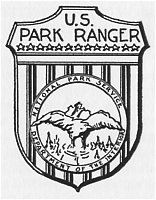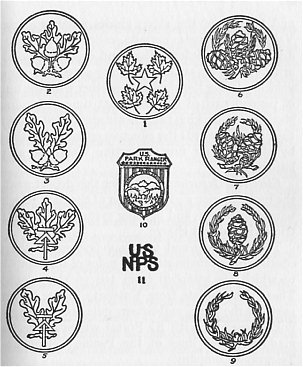Yosemite > Library > Handbook >
Administration >
"Administration of Yosemite National Park"
Handbook of Yosemite National Park (1921)
by W. B. Lewis
Next: Geology of Yosemite
•
Contents
•
Previous: Ideals and Policy of the National Park Service

ADMINISTRATION OF YOSEMITE NATIONAL PARK
By W. B. Lewis
Superintendent, Yosemite National Park
Yosemite National Park,
which covers 1125
square miles, an area nearly as extensive as the State
of Rhode Island, is a national reservation. It is completely
subject to federal administration and is governed
by rules and regulations prescribed by the
Secretary of the Interior under authority of the law.
The enforcement of the laws and regulations is entrusted
to a Superintendent who resides and maintains
headquarters in Yosemite Valley and who is directly
responsible to the Director of the National Park Service,
the chief administrative officer of the entire
National Parks system.
The duties of the Superintendent are multifarious.
He must supervise the many governmental activities,
some of which are the task of building and maintaining
roads and trails; the building of telephone and telegraph
lines and the operation of telephone and telegraph
service within the park, and to the connection
of these lines with the outside commercial lines; the
building of power transmission lines and the operation
of the government-owned and -built 2000 kilowatt
hydro-electric power plant; the building, maintenance,
and operation of the park shops and barns; the construction
and maintenance of living quarters for the
employees of the government; the operation of construction
camps for the working men; the installation,
maintenance, and operation of water and sewage
systems; the care of public grounds; the policing and
maintenance of the public camping grounds, etc.; and
the administration of the park ranger force. The duties
of this last branch of the service include the general
policing of the park for the protection of fish and game,
the prevention and extinguishing of forest fires, the
regulation of traffic, and the general preservation of
order, the checking of automobiles, and the maintenance
of an Information Bureau for the dissemination
of accurate, reliable, and impartial information on all
matters of interest to park visitors.
The Superintendent must also hear complaints,
arbitrate differences between individuals or parties,
supervise the activities of those individuals or corporations
who operate hotels, camps, transportation
services, etc., under government franchise, arid
adjust differences between such individuals and
corporations themselves or between them and the
public.
The Superintendent further has supervision over the
cutting of timber on private lands within the park and
on government lands where, through exchanges with
private owners to preserve privately owned timber
of scenic importance, such cutting is permitted. He
must also see that the government’s interests are not
impaired under the operation of power and water
supply projects where they are authorized by law as,
for instance, in the case with the City and County of
San Francisco in the development of its power and
water supply project in Hetch Hetchy Valley.
With this diversity of governmental activities the
administrative organization is divided into various
departments, each with its supervising officer and
each with clearly specified activities and duties. These
various administrative and operative units together
with their general duties are enumerated below.
Department of General Administration. The Assistant
Superintendent is in charge of this department
and the activities are as follows: general office management;
purchase of supplies and equipment; disbursing
of pay rolls and accounts; timekeeping; accounting;
collections of revenues from sales, franchise fees, and
fees from all other sources; appointments; employees’
compensation; preparation of contracts and vouchers;
sales; and the numerous details of local routine
matters.
Department of Maintenance and Operation. The
activities of this department, which is administered
by a Park Supervisor who is assisted by an Assistant
Supervisor, are the most varied of any of the park
administrative units. They consist principally of
the maintenance of the 138 miles of park roads and
600 miles of trails, of some 200 government buildings,
and of approximately 5 miles of water lines; the maintenance
and repair of all buildings, fences, and bridges;
the care and distribution of stock and transportation
facilities; upkeep and repair of tools and equipment;
care of public grounds and camps; disposal of garbage
and waste; and the production of wood, ice, hay, etc.
Department of Engineering. A Resident Engineer
has direct charge of this unit and his duties consist
mainly of the advisory supervision of all outside maintenance
work; the making of surveys for roads, trails,
pipe lines, etc.; the preparation of plans, designs, and
specifications for construction; and the inspection
contract work.
Ranger Service. It is with this phase of the park
administration that the public comes most in contact.
The Ranger Service consists of a force of from ten to
thirty rangers (depending upon the season of the year)
under a Chief Ranger.
The park is divided into a number of districts and,
during the summer months, in each is stationed a
mounted ranger who is responsible for the proper
patrol of his district. It is his duty to inform, assist,
and instruct the park visitor, to prevent and extinguish
forest fires, to protect fish and game in accordance
with the park rules and regulations, to inspect
camping grounds, and to enforce the rules and regulations,
making arrests when necessary.
Traffic rangers, mounted on horses and motorcycles,
are stationed on the floor of Yosemite Valley. While
their principal duty is to regulate traffic, they must
also be informative to the public, patrol for fire, police
camping grounds, and, in general, preserve law and
order around the village, camps, and hotels.
A specially qualified ranger is also in charge of the
Information Bureau which is maintained at the Park
Headquarters. Here information concerning roads
and trails and all other matters of public interest concerning
the park is given out; campers are registered;
park publications and maps are distributed and sold;
and bulletins concerning roads, trails, and general
park conditions are prepared from time to time for
distribution to newspapers, automobile clubs, and
other organizations interested.
Checking or automobile rangers are stationed at
all of the road entrances to the park, and at the top

NATIONAL PARK SERVICE INSIGNIA
1.—Director of National Parks (Gold Star)
Assistant Director of National Parks (Silver Star)
2.—Park Superintendent
3.—Assistant Park Superintendent
4.—Park Engineer
5.—Assistant Park Engineer
6.—Chief Park Ranger
7.—Assistant Chief Park Ranger
8.—Park Ranger
9.—Temporary Park Ranger
10.—Ranger’s Badge
11.—Collar Insignia
|
and bottom of the steep grades entering Yosemite
Valley. They issue permits, collect automobile fees,
distribute park information, and collect and seal firearms.
Records are kept of every automobile or other
vehicle passing the stations, together with the number
of persons carried and the exact time of leaving the
stations. Checking rangers are also called upon to do
their share towards the effective operation of the park
by observing for fires, reporting violations of regulations,
etc.
Electrical Department. Under this department falls
the maintenance and operation of the park telephone,
telegraph, power, and lighting systems. A Chief Electrician
is in direct charge.
The telephone and telegraph system of the park
consists of approximately 210 miles of telephone lines,
to which are attached from 100 to 175 telephones.
These lines radiate from Yosemite Valley to various
parts of the park, and fifteen miles of telegraph line
links Yosemite with El Portal where connection is
made with the lines of the Pacific Telephone and
Telegraph Company.
A 150-line switchboard is operated continuously on
a 24-hour basis throughout the year, and local and
long distance service may be had from all hotels,
camps, or ranger stations throughout the park.
The main telegraph office is located at the Park
Headquarters Building in Yosemite Village, but
messages may be filed and received at all hotels and
camps. A messenger service is also provided during
the summer months but this is of necessity limited
to Yosemite Valley.
The electrical system consists of a hydro-electric,
power plant of 2000 kilowatt capacity, located on the
Merced River a short distance below the western end
of Yosemite Valley. This plant was completed in
June, 1919, at a cost of $212,000.00 and serves seven
miles of high power transmission line and approximately
nine miles of distributing lines. The energy
here developed is used for power, lighting, heating,
and cooking purposes in the hotels and camps, and in
the residences of park employees and other government
buildings.
Department of Forests and Timber. Under the
supervision of a Park Forester this unit of park administration
is charged with the supervision of timber
operations in the park and the immediate representation
of the federal government on the Hetch Hetchy
project in course of development by the City and
County of San Francisco.
Special work having to do with the forests of the
park is also assigned to this department.
Mechanical Department. This department is presided
over by a Master Mechanic who has charge of
the operation of the machine shop and the maintenance
and upkeep of all motor-driven vehicles. To
him is also assigned the task of advisory supervision
of the upkeep and operation of all power-driven
machinery and plants.
In addition to the more or less specific activities
enumerated above, numerous problems of a special
nature are from time to time taken up in connection
with other bureaus or departments of the State and
National governments. Control of the mosquito nuisance
is carried on in co÷peration with and under
the advice of the United States Public Health Service
of the Treasury Department; the study of forest insects
and application of the findings of the Bureau of
Entomology of the Department of Agriculture in the
elimination of insect depredations on the park forests
are effected by the park force in co÷peration with
that bureau; the planting of fish in the park waters is
done in co÷peration with the California State Fish
and Game Commission; methods for the extermination
of rodents in Yosemite Valley are applied under
the advice of the Biological Department of the Department
of Agriculture; and in co÷peration with the
Forest Service the problem of the preservation of
timber along the roads leading to the park is being
worked out.
Hence the administration of the park, in its position
as a separate and independent nationally governed
unit which compares with the District of Columbia
so far as form and application of government is
concerned, places, on the small scale, upon its administrative
organization many of the same complex problems
of administration and operation that confront
the local government of that reservation—problems
and difficulties that are, however, little realized by the
casual visitor to the park whose soul and mind are
occupied in absorbing scenery and with getting the
fullest enjoyment out of his holiday.
Next: Geology of Yosemite
•
Contents
•
Previous: Ideals and Policy of the National Park Service
http://www.yosemite.ca.us/library/handbook_of_yosemite_national_park/administration.html

